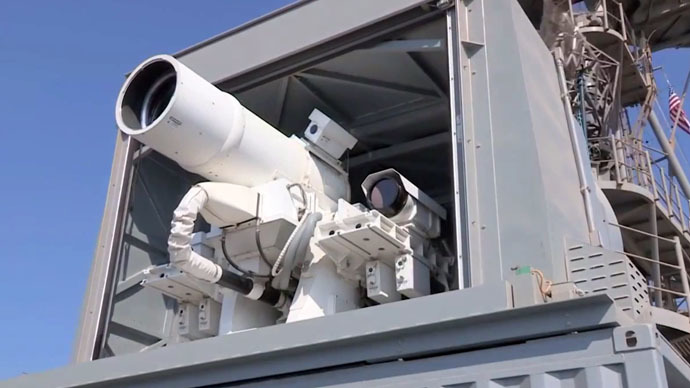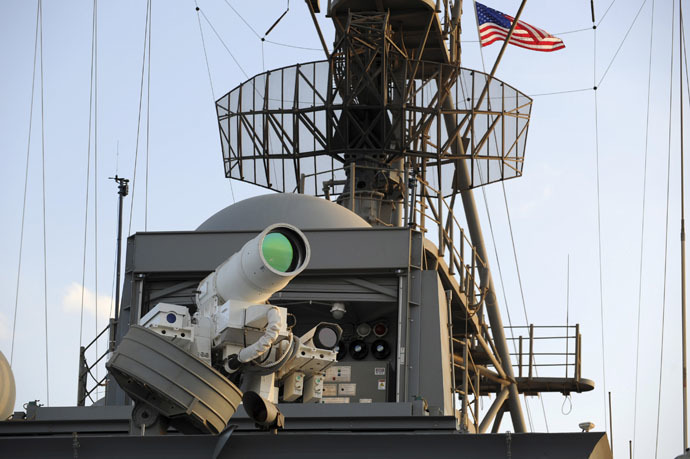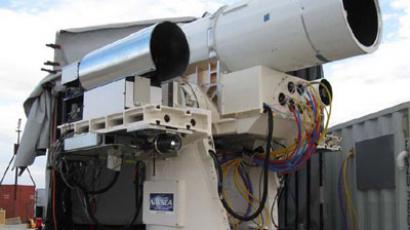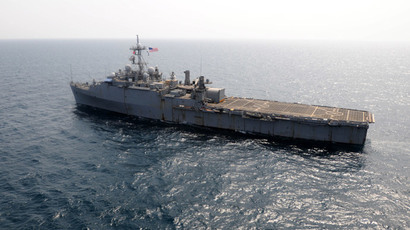Not Sci-Fi anymore: Navy’s 'fully operational' laser gun blows up boats, drones (VIDEO)

The US Navy continues to tout its sophisticated warship laser system, saying it has performed above expectations for the last four months of operational testing aboard the USS Ponce during its deployment in the Persian Gulf.
The $40 million Laser Weapon System (LaWS) was fully integrated on the USS Ponce at the end of the summer for a year of testing, according to Rear Admiral Matthew Klunder, head of the Office of Naval Research.
Recently-released video of the 30-kilowatt laser showed it taking down a small aerial drone in two seconds before the aircraft plunged into the sea.
LaWS works by focusing beams from six solid-state commercial welding lasers into a single strong beam, which can be used both as a blinding warning shot or as a weapon capable of setting fire to anti-ship arms or other threats to US warships, especially small, fast-moving targets.
"This is the first time in recorded history that a directed energy weapons system has ever deployed on anything," Klunder said, according to Reuters.
Another clip in the new video showed LaWS successfully detonating a rocket-propelled grenade shot from a small, distant boat.
"We're not testing it any more. This is operational. It's on a ship in the Persian Gulf," Klunder said. "This isn't something we've got in a box we're saving for ... a special moment. They're using it every single day."
The technology’s big advantage is its operational efficiency, as firing one shot costs just around $1, the Navy has repeatedly stressed. But lasers have their own peculiarities, with efficacy depending on weather conditions, the presence of dust and vapors in the air, and other factors. The range of the LaWS, which is limited by those factors, remains classified.
Despite those hypothetical limitations, the Navy announced that sailors working with the system reported that “the weapon performed flawlessly, including in adverse weather conditions of high winds, heat and humidity.”
There is also the issue of power, which the laser weapon requires in abundance – hence its deployment by the Navy on a warship with powerful generators.
In April, the Pentagon’s top weapons buyer, Frank Kendall, called the deployment of LaWS on the USS Ponce “a worthwhile experiment” because “it’ll help us feel out the operational limitations” such as power constraints.

It was crucial to learn how the system would operate in the environment and how much energy it would consume, Kendall added.
The US Navy has boosted its presence in the Persian Gulf in recent years. The US targeted Iran’s oil industry and financial sector with economic sanctions aimed to add leverage against Tehran over its disputed nuclear program.
Amid the tensions, Iran threatened to close the Persian Gulf’s bottleneck, the Strait of Hormuz, through which one-fifth of the global oil trade passes. Washington’s response was that it would use its Navy to prevent any such blockade.
China, Iran, and other countries have worked to develop precision anti-ship missiles in reported efforts to force a further buffer-zone between their respective shores and the US Navy.
Meanwhile, the US Navy is developing a more powerful 100-to-150-kilowatt laser system that could destroy more sophisticated anti-ship missile technology. That heightened laser system is expected to be ready for deployment in 2017, Klunder said.
For now, the 30-kilowatt LaWS has operated with fantastic precision, the Navy says, though it has not encountered actual threats to the USS Ponce.
"That's all worked well. As a matter of fact, we've never missed," Klunder said. "If we have to defend that ship today, we will destroy a threat if it comes inbound."














